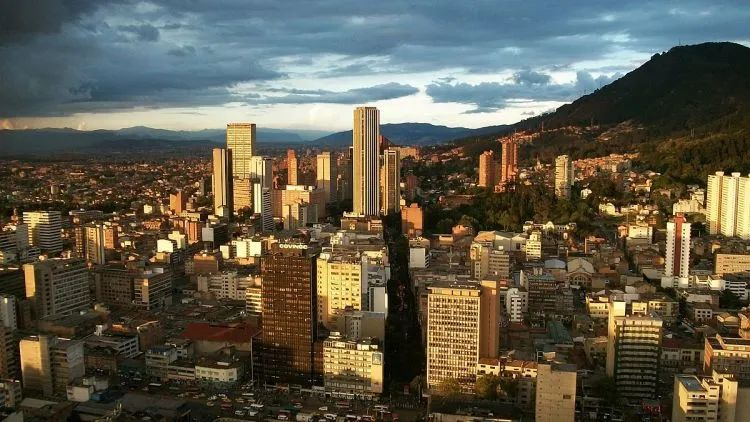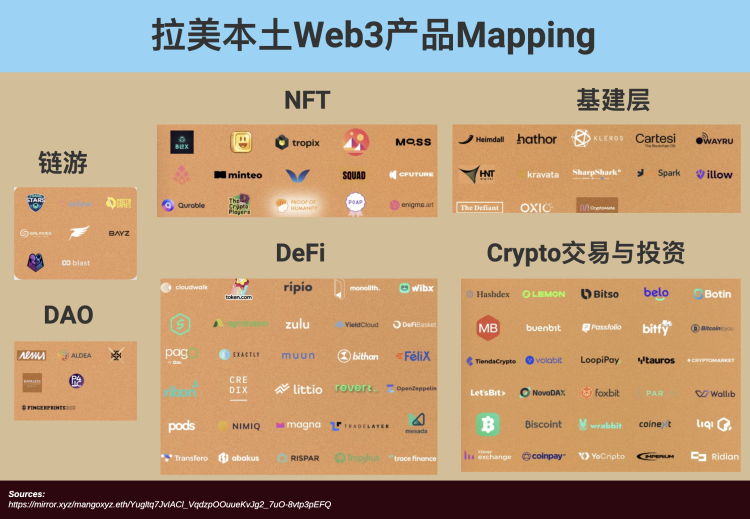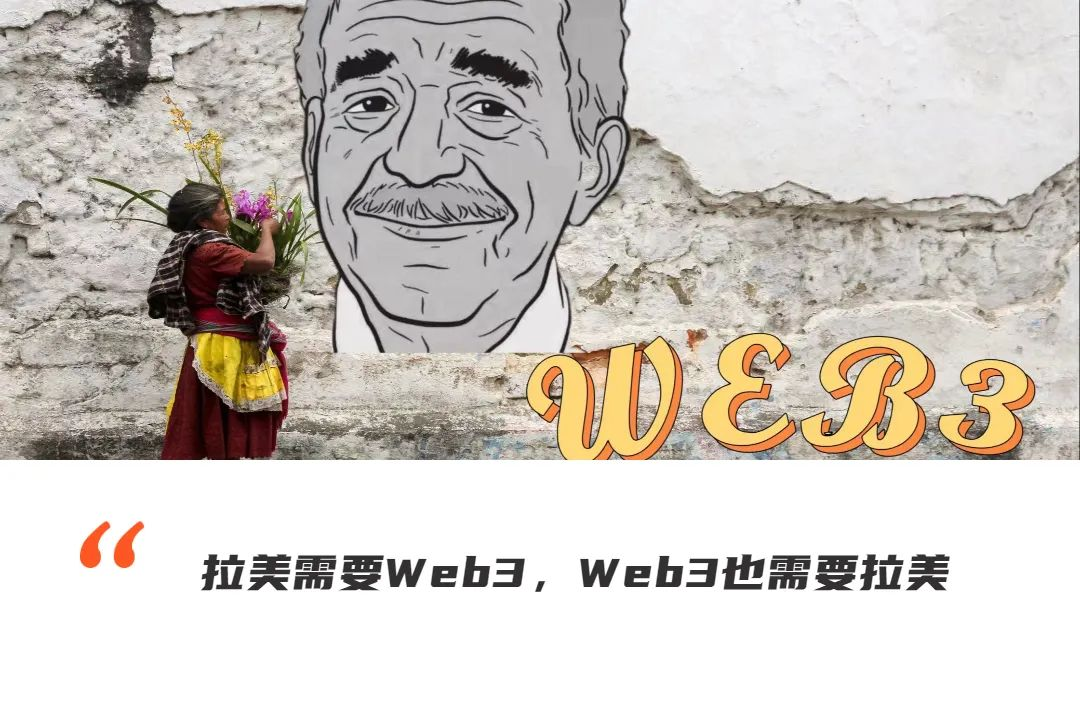Web3 gypsies walk onto Marques’s land, decentralized souls wander in the magical real world.
Web3 wanderers enter Marques's domain, decentralized spirits roam the enchanting real world.Key Points of the Article:
-
Although the Web3 wave originated in Europe and the United States and has received great attention in Asia, the Middle East, and other regions, it is the Latin American region that truly embraces Web3 from the demand side, compared to these “supply exceeds demand” markets.
-
Because there has not yet been a globally phenomenal Web3 product born in Latin America, few overseas entrepreneurs and capital have cast their eyes on it. Although it has a large Web3 user base and a relatively unified market environment in terms of language, Latin American Web3 is still trapped in a “can’t go out, can’t come in” dilemma, but it also greatly weakens the impact of the FTX collapse event on the local area.
-
Adventurous Chinese Web3 practitioners have flocked to Latin America. In front of them are not only the huge potential of Latin American Web3, but also the enormous challenges posed by difficult localization, strong US dollar forces, and scarce technological and talent resources.
Years later, regardless of whether the Web3 revolution finally erupts and happens in which country or region, those Chinese Web3 practitioners who chose to come to Latin America in the second decade of the 21st century are like the gypsies under Marquez’s pen in the last century – they “wander the streets and alleys” in this distant and mysterious land, earning income by introducing “fresh objects” to the locals.
They are not only the messengers of civilization in the era of internet globalization, but also the commercial intermediaries of transnational business, and the foreign fighters who try to explore their own value and destiny through the development and changes of local communities.
What surprises these Chinese people who have traveled through Europe and America, settled in Southeast Asia, and explored the African continent is that the emerging industry of Web3, which is heated by capital in other countries and regions but actually has many bubbles, has rapidly spread and applied from the grassroots users in Latin America, and has pushed the industry and policies forward and improved.
Although the Web3 world is still in a long bear market, Web3 practitioners in Latin America all express that they feel the long-lost vitality on Marquez’s land.
Welcome to the world of magical realism
Several months ago, at the Ethereum Devcon held in Bogota, two things impressed the crypto artist Song Ting deeply: losing her phone and altitude sickness.
In Colombia, the historical stronghold of drug lords, losing a phone seems to be a common occurrence, not to mention the Devcon, which has attracted the attention of many pickpockets as it brings together the elites of technology and the internet from various countries. Song Ting witnessed her friend’s phone being snatched on the street, fortunately without any harm to personal safety. However, the frequent incidents of phone theft at the venue still remain an unforgettable memory for Web3 practitioners on this trip. Even more magical is that even on a foreign continent with an average altitude of nearly 2800 meters, Web3 practitioners from major continents still organized a football match in a local fashion. Song Ting, who participated in the event planning, sighed, “Football knows no borders, and neither does Web3,” while making preparations for medical assistance by contacting local friends in advance for participants who experienced altitude sickness.

Source: unsplash, Bogota at an average altitude of 2,800 meters
Although these experiences are enough to be a topic of conversation for foreigners who have stayed briefly, for the locals living in Latin America day by day, they are just a negligible epitome of the magical realism world. While attending Bogota Devcon in Latin America, Song Ting also participated in the Mexico Web3 hackathon. As she interacted with more and more local practitioners, she saw a more real Latin American world. Native Latin Americans told Song Ting that the “exchange rate earthquake” was more magical but also more common than losing a phone and experiencing altitude sickness. “The exchange rate of the Colombian peso and the Argentine peso can fluctuate by 80% in three days, and it’s not just fluctuating up and down, but only falling. Local newspapers often report news of inflation rates of over 50%, but residents are not allowed to have any currency other than the local peso in their local banks.” Song Ting told me that this means that the locals who deposit their savings in the local banks are essentially gambling all their assets on the credit of the country’s government and the future of its fiat currency. The reality has proven to be cruel for many people. “This is also one of the reasons why many ordinary people in Latin America actively embrace cryptocurrencies. They are voting with their feet to choose Web3, just to be able to survive as a family.” Peng Sisi, a Web3 entrepreneur who has traveled in Latin America for many years, has had similar experiences and feelings about the local magical financial system.
During her research on cryptocurrency regulatory policies in Rio de Janeiro, Brazil, Peng Sisi was surprised by the absence of traditional finance in the local area: traditional banks in Brazil only serve the middle class and above, while people with average or relatively poor economic conditions are either rejected from opening an account or required to pay interest rates as high as 300%. In contrast, the level of trust that local people have in traditional banks in Latin America is also very low. “They would rather keep their money at home than put it in a bank. Moreover, a considerable number of Latin Americans work in the United States. When they send the dollars they earn back home, they not only suffer from the impact of local currency inflation, but also have to pay high fees. Therefore, in recent years, many Latin American workers have been sending money back through Bitcoin transfers.” Peng Sisi said. In Peng Sisi’s communication and research with local government agencies and ordinary people, she found that this extreme distrust of the traditional financial system by the Latin American people has a long history. In fact, most countries on the Latin American continent have been in great economic turmoil for over 40 years. After the debt crisis in the 1980s, many countries adopted liberal economic policies, including implementing an open financial system. However, with the influx of foreign capital and the generally poor management capabilities of Latin American governments, the local traditional banks that were impacted have collapsed one after another, causing countless Latin American people to suffer heavy losses.
Source: unsplash, magical realism in Latin America
What makes it even more unbearable for the Latin American people is that traditional banks in Latin American countries are mostly controlled by local financial oligarchs, implementing an oligopolistic operation. “There is a minimum deposit requirement for opening a regular account locally, and in addition to paying management fees every month, there are various fees to be collected. These banks, which can almost make money while lying down, are too busy serving large enterprises and the elite class, and they have no motivation to reach ordinary people.”
In Peng Sisi’s many years of observation, she found that even if Latin American government officials have the intention to change this situation, they often get involved in struggles with the interests of the financial oligarchs and cannot make a move. But it is this magical realism land that provides a free soil for the rapid development of Web3. After the FTX collapse event dragged the entire crypto world into another Lehman moment, the degree of impact on the Latin American region was not high. Although there were signs of decline in local transactions and investments related to the crypto industry, Web3 as a whole is still on the rise. At the same time as FTX announced bankruptcy, Brazil also passed a bill allowing the use of cryptocurrencies in the country.
A senior analyst at a research institute told me that Web3 in Latin America has strong regional characteristics, which has given rise to many local exchanges. Although Latin America has not produced globally phenomenal crypto products and has received little attention from the outside world, it has also avoided many potential risks.
| Web2 and Web3 walking side by side, huge potential and immaturity
Web3’s rampant growth in Latin America has even broken many rules and concepts established in other countries and regions. The most obvious is the magical landscape of Latin American Web3 and Web2 walking side by side, competing and complementing each other. Yin, who is doing Web2 entrepreneurship in the Latin American region, recently decided to fully integrate Web3 elements into the product. Metaverse Z, founded by him, is currently the largest game community platform in the Latin American market, operating in several countries including Brazil, Mexico, and Argentina.
As early as a few years ago, Yin noticed the uniqueness of the Latin American Web3 ecosystem. Although the hottest trend at that time was still the financial track based on cryptocurrencies, unlike Europe, America, and Asia, the products of Latin American Web3 and Web2 were very well integrated, and many cryptocurrencies were embedded into the Fintech (financial technology) that emerged during the Web2 era. In countries like Mexico and Argentina, even coffee shops on the streets and alleys accept stablecoins in online payment apps as payment. Many offline stores even actively display signs saying “CRYPTO”, reminiscent of the scene when WeChat Pay first started to become popular in China.

Image source: Internet
This scene, which enjoys the dividends of both Internet eras, also fits well with the background of Latin American magical realism. “You can see conservative people using Fintech for encrypted stable coin transfers, and you can also witness speculative people rushing into exchanges to trade coins.” In fact, the mobile Internet wave swept Latin America even later than Southeast Asia. Just like Southeast Asia almost skipped the PC era and directly entered the mobile Internet era, the rise of Latin American Web2 and Web3 in succession is competing for the main track of the local Internet, and the latter even has a trend of overtaking the former. Since this year, Yin has felt more clearly the surge of the Latin American Web3 wave. “There are more and more Generation Z users starting to discuss Web3 on our platform and suggesting that we launch related features and gameplay to meet their needs.” Yin told me that cryptocurrencies and blockchain technology have been widely used in Latin America since 2019, including countries like El Salvador using Bitcoin as legal tender to escape economic inflation. In addition, the global Internet growth brought about by the epidemic has led to the emergence of Web3 application layers such as blockchain games and NFTs. Chinese Web3 institutions that have also started to enter the Latin American market have seen the potential of the local application layer. The relevant person in charge told me that the development of blockchain games in Argentina and Venezuela is very rapid and can compete with the Philippines and Vietnam. “However, we have observed that the blockchain games in Latin America are mainly introduced by foreign products like Axie Infinite, and local games did not develop much in the last bull market. But now, many entrepreneurs have started to lay out.”

Image source: compiled by the author
Under the semi-active and semi-user-driven model, Yin decided to develop his own entrepreneurial product into a gateway connecting the Latin American Web2 and Web3 gaming communities. The overall business model is to attract users through Web3 social networking, and then use NFTs as a medium to help distribute games and monetize influencer content. “We are not completely transitioning to Web3. If we completely abandon the form of Web2, we are likely to become a financial product. It’s not that financial products are bad, but Web3 financial products rely more on Ponzi economic models, which are essentially a zero-sum game. However, if we want to promote Web3 more universally to the public, it must be combined with specific consumer scenarios.” In Yin’s view, the development path of the Internet in each country and region has its own characteristics, and the current Latin American Web3 application layer needs to be combined with Web2 to maximize its advantages. The former can even achieve overtaking with the help of the latter. “The industry growth is essentially driven by demand, which is the biggest advantage of Latin American Web3 because the completeness of Web2 in Europe, the United States, and Asia has already covered the daily needs of most users, especially North American Web3. It often creates demand scenarios to promote its own development.”
Before coming to Latin America to start a business, Yin had been involved in building social products for young people in North America for a long time. He does not believe that the explosive growth of Web3 in the future will happen in the North American market, “because North American users do not have a pressing need to be satisfied by Web3, so it cannot cultivate a large number of mass users who believe in cryptocurrencies and Web3”. However, the huge potential for Latin America to overtake in the Web3 curve is accompanied by great immaturity. Yin often feels that the local Web3 entrepreneurial ecosystem in Latin America is like China 20 years ago when it just entered the Internet era, in a stage of high dependence on foreign technology, business models, and capital. “Most of the Web3 entrepreneurs in Latin America are locals, but if you look at their backgrounds, you will find that most of them have had relevant experiences in North America, such as Miami and Silicon Valley, just like Zhang Chaoyang and Robin Li in the early days of the Chinese Internet, studying and observing the local Internet business models in the United States, and then starting their own businesses when they returned to China.” The dependence of Latin American Web3 on the United States is also reflected in capital. Many influential locals maintain close ties with the Web3 community in the United States, hoping to win recognition from US dollar capital and obtain investment. As for countries in Latin America such as Mexico, Colombia, and Brazil, although there is also a certain clustering effect of Web3, there are still more important nodes radiating Latin America from North America.
Difficult Localization: Conflicts, Fragmentation, and Trust Barriers
Compared to the immaturity of Web3 in Latin America, Chinese participants involved in local industry building all mentioned another bigger challenge—the localization.
This problem that has existed since the first day of the Internet’s foray into foreign markets is magnified several times on this magical and realistic land of Latin America. For Chinese Web3 practitioners who are new to Latin America, the first and most obvious challenge of localization is learning to speak Spanish. In the contact with locals, Song Ting found that it takes more time to establish trust and become business partners with Latin Americans. The first hurdle to overcome is language. “The vast majority of Chinese entrepreneurs will not actively learn Spanish. Although work communication can also be done in English, it is very difficult to make progress without knowing any Spanish,” said Song Ting.
The importance that Latin Americans attach to localization and the unbreakable trust barriers are directly reflected in the proportion of Chinese-background Web3 companies’ employees. Chen Qi, who mines and runs a crypto arbitrage fund in Paraguay, has built a small Web3 startup team in less than two years. Among these employees, including himself, there are only three Chinese, and the rest are locals. When it comes to the localization challenges faced by Chinese Web3 practitioners in Latin America, Chen Qi frankly stated that mining and arbitrage in Latin America is somewhat clever. “Essentially, we are bringing new money to Latin America, and the source of income is plugged into the faucet of the Federal Reserve. This does not cause a problem of snatching jobs from locals, so it reduces the difficulty of localization to some extent.” However, even so, Chen Qi still encountered many localization challenges in the process of starting a business in Latin America. Influenced by the overall environment, Latin Americans inherently possess two characteristics: contentment with poverty and enjoying the present moment. This also means that the internet company culture that Chinese entrepreneurs are accustomed to cannot be applied locally. “There are big cultural differences. If you use the management methods of Chinese internet companies, not only will the cost be high, but if you mention the concept of ‘996’ to Latin Americans, they will directly turn their faces away from you. So we can only let locals handle management.” Chen Qi told me that although this model does not make Latin American internet companies run fast, it is currently an effective way to achieve localization in Latin America, and it is more valuable to enter the market early than blindly pursue efficiency.
Image Source: unsplash
However, gaining the trust of Latin Americans is just the first step for Chinese Web3 practitioners to break through in the local market. More severe challenges follow. Behind the long-standing turmoil in Latin America, in addition to the inaction of the local governments and power struggles with the oligarchs, the ubiquitous influence of the US dollar has also affected this land for decades. This economic hegemonic system has also extended to the Latin American Web3 world, causing new conflicts and divisions.
Another important task for Song Ting’s visit to Latin America is to promote NFT art in collaboration with cultural departments in several countries in Latin America. As a crypto artist who has been ranked among the top 20 globally, Song Ting’s NFT works have been translated into Spanish and introduced to Latin America in the past two years. The high popularity can be seen from the collection of the National Museum of Venezuela. With the increasing attention to Song Ting’s NFT art in Latin America, Christie’s in Argentina and Mexico also extended invitations to her, hoping to feature her encrypted works as the first NFT art auction in Latin America. “This is very important for me and the development of the local NFT ecosystem. After the auction, Argentina and Mexico can start promoting more Web3 activities, which will definitely attract many Web3 entrepreneurs and tech elites. This is a great opportunity for local resource integration and education market,” Song Ting said. However, just when Song Ting and Christie’s in the two countries had been working hard for nearly two years and were about to achieve their goals, the main partner of Christie’s, a NFT trading platform giant in North America, abruptly halted everything. “From multiple communication negotiations, this NFT trading platform does not want the first auction in Latin America to feature works created by non-Western artists. They don’t want a non-commercial PFP art piece with weak financial liquidity,” in the initial days when Song Ting was rejected by the North American NFT giant, apart from feeling lost and regretful, she had actually accepted this established result. On the contrary, the local staff of Christie’s in Argentina and Mexico showed deep frustration and anger. “They started to battle for me with the headquarters in New York, protesting against those white men sitting in the downtown office in New York, because they hoped that person would be me. They hoped to break through the numerous obstacles set by our powerful neighbor and push history forward a step through this matter,” Song Ting told me that because NFT art in Latin America is still in its early stages, her encrypted works are a powerful icon in the local Web3 world and can drive more tech enthusiasts to join. “To some extent, it’s like ‘a gem from another mountain may be used to polish the jade’.” However, the outcome of the matter is somewhat regrettable. After various efforts, Song Ting’s encrypted art still did not become the first NFT artwork in Latin America. But this process has deepened her connection with the local Web3 community. “Not all Latin American people are against the market dominated by US dollar funds. Many people even take it for granted. But a part of the young people in Latin America and crypto artists like me have the same aspirations. We hope that Web3 is a world where diverse ethnic groups can participate together,” Song Ting described this seemingly distant but highly probable future as “helplessly hopeful”.
| Final Thoughts
For Chinese companies and investors, Latin America has always been a distant and unfamiliar market, relatively impoverished and backward in their impression. In recent years, domestic technology and internet companies have increasingly regarded globalization as their second growth curve, but Latin America is often their choice after Southeast Asia, Europe, North America, the Middle East, and even Africa. Moreover, Chinese companies that have made a big push into Latin America are mainly internet giants and emerging unicorns. Although this situation has changed somewhat with the rise of the Latin American Web3 wave, all the interviewees in the article stated that “Latin America has not yet formed a circle of Chinese Web3 entrepreneurs.” “The Latin American Web3 market is still in a very early stage, but it is precisely because of this that Chinese practitioners have the opportunity to lay out in important areas such as infrastructure and traffic entry points.” Song Ting plans to live and work in Latin America for a period of time every year in the future, personally participating in and witnessing the development of local crypto art. Yin’s Web3 functionality has officially launched, and he is looking forward to catching the wave of the explosion of Latin American blockchain games. However, with the growth of blockchain games, the problem of insufficient local technical talent in Latin America has been exposed. Yin has currently placed part of his team in Southeast Asia, hoping to make up for the shortcomings of Latin America with the overflow of technical resources from Asia. Chen Qi is also working hard to expand Web3 new businesses. He has found that the local “Old Money” is gradually showing great interest in the crypto world. Therefore, he plans to reuse the experience and resources accumulated in the European and American markets in the Latin American market, and compete with FA institutions with European and American backgrounds to provide higher cost-effective and higher quality investment services for Latin American “Old Money”. Peng Sisi, relying on her Web3 research experience in China and Latin America, has established a consulting firm, ChinAmigo, which connects the technology markets of the two regions. She described the current situation in both China and Latin America as “Chinese people know very little about the Latin American market and dare not enter, while local Latin Americans are limited by business models and global perspectives and lack the awareness to go abroad.” She hopes to change this to a certain extent. This magical and realistic continent, once acclaimed by the world because of Marquez, may now grow something just as fierce in the Web3 world.
We will continue to update Blocking; if you have any questions or suggestions, please contact us!
Was this article helpful?
93 out of 132 found this helpful
Related articles
- Reviewing the NFT Cold Winter of the past half year Who is ‘surrendering’ and who is growing against the trend?
- Is the golden age of scamming over? Connext’s witch-hunting program goes awry, community poisoning becomes the norm.
- LianGuai Observation | Connext Witch Hunt Program Provokes Public Anger, Poisoning may be the only solution?
- Reviewing the Development History of Web2 Game Engines and Exploring the Future Development Path of Full-Chain Games
- Intent-driven Best practices for Web3+AI?
- In-depth analysis of Pendle LSDfi integrates RWA DeFi Lego to stack new puzzle blocks
- Exclusive Interview with Connext Adopting a Points Mechanism to Determine the Number of User Airdrops, with Plans to Expand to 20 Chains by the End of the Year







